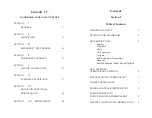
SECTION 4
NORMAL PROCEDURES
WING FLAP SETTINGS
CESSNA
MODEL 172R (180 HP)
Normal takeoffs are accomplished with wing flaps 0
°
-10
°
. Using
10
°
wing flaps reduces the ground roll and total distance over an
obstacle by approximately 1 o percent. Flap deflections greater than
10
°
are not approved for takeoff. If 10
°
wing flaps are used for
•
takeoff, they should be left down until all obstacles are cleared and
a safe flap retraction speed of 75 KIAS is reached. On a short field,
10
°
wing flaps and an obstacle clearance speed of 56 KIAS should
be used.
Soft or rough field takeoffs are performed with 10
°
flaps by lifting
the airplane off the ground as soon as practical in a slightly tail low
attitude. If no obstacles are ahead, the airplane should be leveled
off immediately to accelerate to a higher climb speed. When
departing a soft field with an aft C.G. loading, the elevator trim
should be adjusted towards the nose down direction to give
comfortable control wheel forces during the initial climb.
CROSSWIND TAKEOFF
Takeoffs into strong crosswind conditions normally are performed
with the minimum flap setting necessary for the field length, to
minimize the drift angle immediately after takeoff. With the ailerons
partially deflected into the wind, the airplane is accelerated to a
speed slightly higher than normal, then pulled off briskly to prevent
possible settling back to the runway while drifting. When clear of the
ground, make a coordinated turn into the wind to correct for drift.
ENROUTE CLIMB
Normal climbs are performed with flaps up and full throttle and at
speeds 5 to 1 O knots higher than best rate-of-climb speeds for the
best combination of performance, visibility and engine cooling. The
mixture should be full rich below 3000 feet and may be leaned
above 3000 feet for smoother operation or to obtain maximum RPM.
If an obstruction dictates the use of a steep climb angle, the best
angle-of-climb speed should be used with flaps up and maximum
power. Climbs at speeds lower than the best rate-of-climb speed
should be of short duration to improve engine cooling.
4-24
Oct 4/01
Summary of Contents for 172R180HP
Page 4: ...I I I _ I l...
Page 6: ......
Page 15: ...t GENERAL...
Page 16: ...1 J a w z w c...
Page 43: ...2 r 3 0 z...
Page 44: ...2 v z 0 i e i...
Page 46: ...l...
Page 60: ...i c t...
Page 61: ......
Page 62: ......
Page 85: ...4 oz 0 m J J 03 C i...
Page 86: ...I 4 w a 5 a w ou zO a a...
Page 90: ......
Page 128: ......
Page 129: ...ll PERFORMANCE...
Page 130: ...5 w u z a 0 a Ao...
Page 132: ......
Page 154: ......
Page 155: ...6...
Page 156: ...J WEIGHT BALANCE n EQUIPMENT LIST J...
Page 158: ......
Page 187: ...AIRPLANE SYSTEMS DESCRIPTIONS...
Page 188: ...J AIRLANE SYSTEMS DESCRIPTIONS...
Page 192: ......
Page 239: ...co HANDLING _ SERVICE MAINTtNANCE...
Page 240: ...fa...
Page 265: ...9 en C r m 3 m z en...
Page 266: ...9 z w E w _ Q Q...
Page 268: ......
Page 270: ...I...
Page 288: ......
Page 298: ......
Page 396: ......
















































